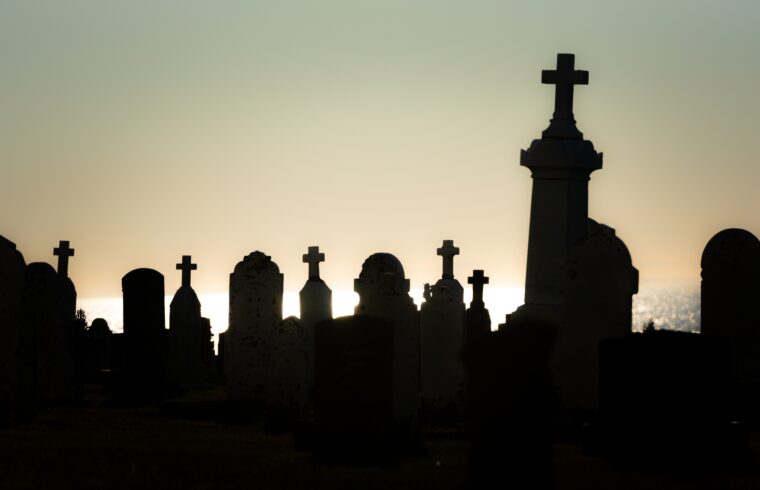Not too long ago, I heard a speaker share a memorable quote. He said: “Everyone dies twice – the first time when the heart stops beating and the synapses in the brain shut down. The second time is when the dead person’s name is uttered, read, or thought of for the last time, after fifty, or hundred or four hundred years…” It’s a sobering and dramatic thought, to be sure, which is why I remembered it. Interestingly, as I was trying to pin down the origins of the original context that it came from, Google didn’t even know. It gave results attributing that quote to the American author Ernest Hemingway; the English street artist/political activist known as Bansky – as well as saying it’s actually something the Egyptians said while others crediting it to Jewish tradition.
Thanks so much for stopping by to read this homily for the SOLEMNITY OF ALL SAINTS- November 1, 2023. I appreciate your sharing this on your social media posts and your feedback and comments… I’m also grateful for all those who’ve asked for the audio version and share them as well at SOUNDCLOUD click HERE or from ITUNES as a podcast HERE. May the Lord be glorified in your reading and sharing- Father Jim
The variations of the quote and the frequency it has been and is used (thank you again, internet) are kind of fascinating. Coming from different traditions, is it meant as a call to avoid pride, embrace humility, and recognize how fleeting is the praise of the applause of the world? When it’s attributed to an artist or a writer, are they expressing hope that somehow their works will perhaps extend their life by being remembered after their physical deaths?
Whichever interpretation, there’s something incredibly somber about those words. Humanity has struggled with self-awareness, learning about birth, dealing with the certainty of death, and responding in a wide variety of ways. Particularly around this time of year, we see it on full display. People making gravestones and coffins for decorations – A block away from here, one of our neighbors has this rather unique display of what has to be 50 skeletons looking like they are attacking the house. With the paganization of our Christian culture and our holidays, these days of Halloween and the days after have perhaps even more disastrously lost any connection to faith than what the Hallmark Channel’s assault on Christmas has been, but I digress.
Halloween begins an intentional time for the Christian to reflect on the “Final Things.” The realities of Heaven, hell, purgatory, death, and judgment. We start by recalling all those who are in Heaven, who are called Saints. That’s the simplest, most straightforward, and most concise definition. The ones who are in God’s Holy Presence for all eternity are the Saints. That’s where the name “Halloween” came from. When we say “hallowed be thy name” in the “Our Father,” we’re saying “Holy is your name.” So the “Hallowed” ones are the Holy Ones. October 31, being the “Eve” of All Saints Day, was called “All Hallows Eve” (like we call December 24, Christmas Eve”), and All Hallows Eve eventually became Halloween.
In this feast, the Church celebrates not just all the Saints we know and admire the ones that we ask for their prayers – like we’ve been doing throughout October for Pope St. John Paul II or Saint Simon and Jude, who shared a feast day on Saturday. This feast day is for all the ones we don’t know. The ones who, you could say, in the views of the world, fall into the category of having died twice: their physical life has ended, and their names are not remembered, not spoken of anymore that they have for all intents and purposes been forgotten.
But not quite. That’s why this is a feast of great joy and hope for us. They are part of the great multitude that St. John had a vision of in the first Reading from the Book of Revelation, where he saw “a great multitude, which no one could count, from every nation, race, people and tongue.” They are the ones who, at one time, were like us as John explains in his letter in the Second Reading. Were God’s children – but now they “see Him as He is.”
God lives. And the fullness and beauty of Heaven is that for those who embraced their identity as God’s beloved sons and daughters, strived to follow Him by letting these words of the Gospel, the beatitudes reshape their vision and conforming their lives to pursuing being “blessed” in the things Jesus calls us to; after their hearts have stopped beating, the synapses in their brains have shut down found their lives have not ended. Because God, the source of life, utters their names for all eternity. They are seen, known, embraced, and loved by Him. And they now join the great cloud of witnesses praying for us. Praying that we do not fall for the lies of the world that looks for acclaim and to be spoken of by mere mortals, praying that we resist the lies of the evil one sowing seeds of despair and distress. Praying that we follow their example, follow Jesus, and be found worthy to join them at the ends of our earthly lives.
All Holy Men and Women, Pray for us!











